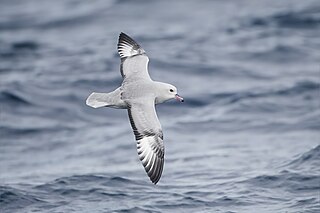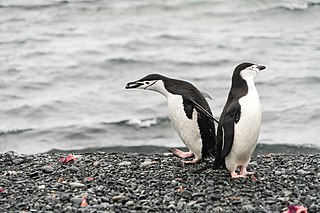
Thurston Island is a largely ice-covered, glacially dissected island, 135 nautical miles long and 55 nautical miles wide, lying between between Amundsen Sea and Bellingshausen Sea a short way off the northwest end of Ellsworth Land, Antarctica. The island is separated from the mainland by Peacock Sound, which is occupied by the west portion of Abbot Ice Shelf.
Martin Peninsula is a peninsula about 60 nautical miles long and 20 nautical miles wide that is ice-covered except for a few rock outcrops along its margins, located between Getz Ice Shelf and Dotson Ice Shelf on the coast of Marie Byrd Land, Antarctica. The farthest point of the peninsula is Jacobsen Head.
Edward VIII Bay is a bay about 32 kilometres (20 mi) in extent, located between Edward VIII Plateau and the Øygarden Group of islands in Antarctica. The head of the bay is occupied by the Edward VIII Ice Shelf. The bay was discovered in 1936 by Discovery Investigations personnel on the RRS William Scoresby, and named for Edward VIII, then King of the United Kingdom.

Annenkov Island is an island in South Georgia and the South Sandwich Islands, to the west of the main island of South Georgia. The Pickersgill Islands are to its southeast. It is irregularly shaped and 4 miles (6.4 km) long and 650 m (2,130 ft) high, lying 8 miles (13 km) off the south-central coast of South Georgia.
Black Rock is a low rock 10 miles (16 km) southeast of Shag Rocks and some 105 miles (169 km) west-northwest of South Georgia. Black Rock may have been considered as part of the "Aurora Islands" reported in this vicinity by the ship Aurora in 1762. It was charted in 1927 by Discovery Investigations personnel on the William Scoresby.

Morton Strait is the 9 km (4.9 nmi)-long and 6.2 km (3.3 nmi)-wide strait between Snow Island on the southwest and Rugged Island and Livingston Island on the northeast, in the South Shetland Islands, Antarctica. The Aim Rocks and Long Rock lie in the strait.
The Land Glacier is a broad, heavily crevassed glacier, about 35 nautical miles long, descending into Land Bay in Marie Byrd Land, Antarctica. It was discovered by the United States Antarctic Service (1939–41) and named for Rear Admiral Emory S. Land, Chairman of the United States Maritime Commission.
Bolinder Bluff is a prominent bluff crowned by three buttresses of dark grey and light brown rock, overlooking Venus Bay 3 nautical miles (6 km) southeast of False Round Point on the north coast of King George Island, in the South Shetland Islands. The feature was known to sealers using the anchorage at nearby Esther Harbor in the 1820s. It was charted and named by Discovery Investigations personnel on the Discovery II in 1937 when the breakdown of the Bolinder boat engine caused 6 men to be marooned for 9 days on the beach at the foot of the bluff.
Boot Rock is a rock, 30 metres (100 ft) high, which lies 0.1 nautical miles (0.2 km) off the southeast side of Candlemas Island in the South Sandwich Islands. It was charted and named by Discovery Investigations personnel on the Discovery II in 1930.
Borge Bay is a large, irregularly-shaped bay that dominates the east side of Signy Island, in the South Orkney Islands of Antarctica. It was charted in 1912 by Norwegian whaling captain Petter Sorlle, and named for Captain Hans Borge of the Polynesia, who undertook additional mapping of the bay during the following year. It was charted in more detail in 1927 and 1933 by Discovery Investigations personnel, who named many of its features. It was surveyed further in 1947 by the Falkland Islands Dependencies Survey (FIDS), which named several other features.
Brimstone Peak is a conspicuous peak surmounting the rocky headland between Venus Bay and Emerald Bay, on the north coast of King George Island in the South Shetland Islands. The name North Foreland originally appeared for this feature on a chart by British sealer Captain George Powell in 1822, but this name has since become firmly established for the northeast cape of King George Island. The name Brimstone was applied in 1937 by DI personnel on the RSS Discovery II, because of its yellow brimstone color.
Caroline Bluff is a bluff lying one nautical mile southeast of North Foreland, King George Island, in the South Shetland Islands. The bluff was charted and named "North Foreland Head" by Scottish geologist David Ferguson in 1921. To avoid confusion with North Foreland, the UK Antarctic Place-Names Committee rejected this name in 1960 and substituted a new one. The Hobart sealing vessel Caroline visited the South Shetland Islands in 1821–22.
Cove Rock is a low offshore rock 3 nautical miles (6 km) west of North Foreland, King George Island, in the South Shetland Islands. It was charted by Discovery Investigations in 1937 and called descriptively Cone Rock; the spelling Cove Rock, likely through error in transcription, appeared in a Hydrographic Office publication in 1942, and became established.

Kukri Hills is a prominent east-west trending range, about 25 nautical miles (46 km) long and over 2,000 metres (6,600 ft) high, forming the divide between Ferrar Glacier on the south and Taylor Glacier and Taylor Valley on the north, in Victoria Land, Antarctica. They are south of the Asgard Range, east of the Quartermain Mountains and north of the Royal Society Range.

Eadie Island is an island 2 km (1.2 mi) long which lies between Aspland Island and O'Brien Island, in the South Shetland Islands of Antarctica. A strong marine channel, named Tasman Rip, runs between Eadie Island and O'Brien Island.
Emerald Cove is a cove 2 nautical miles (4 km) wide, lying between North Foreland and Brimstone Peak on the north coast of King George Island, in the South Shetland Islands. The name "Shireff's Cove" was given by William Smith in 1819, after Captain William H. Shirreff of the Royal Navy, to whom he reported his discovery of the South Shetland Islands. In 1820, Smith's description of his landing on North Foreland was confused with his description of features on northern Livingston Island, and the name was applied to a feature on that island, where it has been officially accepted. The name "Emerald Cove" was applied by the UK Antarctic Place-Names Committee in 1960 and is for the brig Emerald from Boston, MA, which visited the South Shetland Islands in 1820–21 in company with the Esther. These two vessels rescued the crew of the Venus from Esther Harbour in March 1821.

False Round Point is a point 16 km (9.9 mi) west of North Foreland and 4 km (2.5 mi) south of Ridley Island, on the north coast of King George Island in the South Shetland Islands of Antarctica. The point has appeared on charts since about 1822. It was probably named for its similarity to Round Point, which lies 22 km (14 mi) to the west, by Discovery Investigations personnel on the Discovery II who charted the north coast of this island in 1937.
Tapsell Foreland is a borad, mostly snow-covered foreland jutting into the sea between Yule Bay and Smith Inlet, northern Victoria Land. Much of the central portion of this feature rises above 800 metres (2,600 ft).
Skarvsnes Foreland is an extensive foreland surmounted by bare rock peaks and indented by several coves, protruding into the east part of Lutzow-Holm Bay, Antarctica. It was first mapped by Norwegian cartographers from air photos taken by the Lars Christensen Expedition (LCE) of 1936–37. Its name means "barren mountain headland." Most other features on the foreland were mapped and named by LCE personnel, with a few others mapped from surveys and air photos by Japanese Antarctic Research Expedition (JARE) of 1957–62. Unless otherwise specified, the following features were mapped and named by LCE personnel.

Hole Rock is the largest of several rocks lying close north of North Foreland, the northeast cape of King George Island, in the South Shetland Islands. It was charted in 1937 by Discovery Investigations personnel on the Discovery II and so named because a conspicuous hole extends through it.







